Hi folks,
I'm currently coming towards the end of reroofing our victorian mid terrace house.
It's been a long process. (The previous owners had removed several huge purlins during a very bad loft conversion, installed very inadequate ones and then installed installed heavy concrete roof tiles. (A terrible combination leading to a very bowed roof!)
All of that's been resolved and now I've come to dealing with the last of the three chimneys.
This one is to the very rear of the house and rendered in sand and cement. I have already repointed the other chimneys in lime and given them a new lime flaunching.
These were not rendered so they were much more straight forward to deal with.
Here's the chimney in question. Half our's, half our neighbours.
Below the chimney I rebuilt the top few courses of brick on the gable as what was there had totally disintegrated.
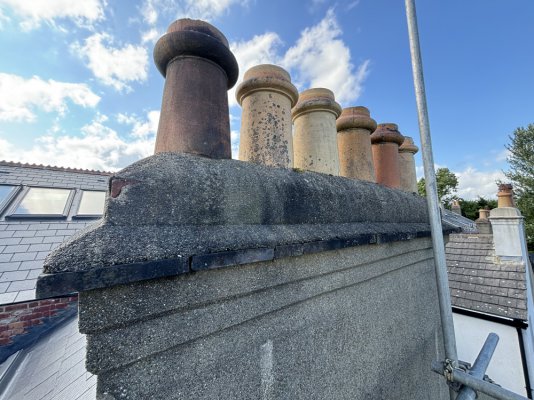
It seems generally in ok condition. However the sand and cement the reverse side on had cracked quite badly around the lead flashing so I started to remove the loose render.
As I was chipping it away I discovered the bricks behind are very loose, the mortar is pretty much dust. (The bricks and mortar below the roofline are fine).
When it was previously rendered there was not enough room left to allow for an adequate lead upstand (much less than 100mm).
Given the condition of the bricks I put down the chisel and have begun to grind the mortar away with a surface grinding disc instead. Not ideal I know, but I don't want to chisel it as the bricks are very loose.
There's also a little bit of a lean on the stack, so again I'm trying to be cautious.
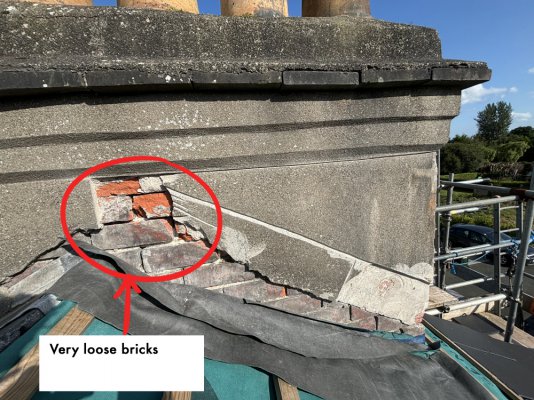
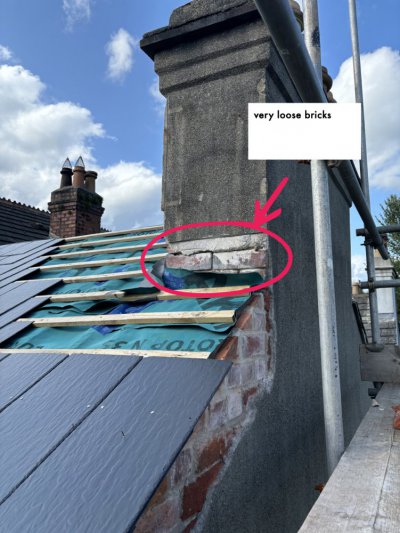
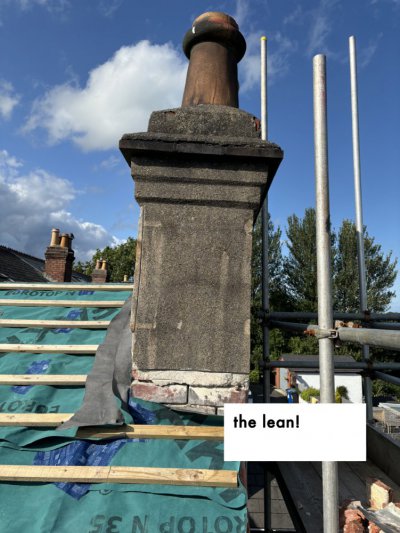
I'm in two minds with how to proceed.
Should I just take the render back enough to allow for good amount of lead coverage and then repair/rebed the loose bricks one by one and then add new lead flashing and re-render with a bellcast/bead?
Or should I remove that section of render completely, repair the bricks and then install more traditional stepped flashing without re-rendering? (I've installed stepped flashing elsewhere)
There's a huge amount to do on this house so I also don't want to just make more work for myself!
The top of the chimney is not in terrible condition but it does have a few cracks. I'm hesitant to take this this off when it seems to be in ok condition. I think here I will just seal up the cracks with lime.
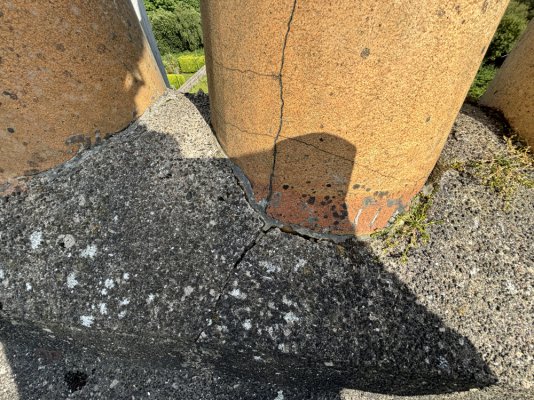
To further complicate things, if I sit on the roof and look side on at the tiles under the flaunching
I can see daylight right out the other side of the chimney! I plan to point all of this up.
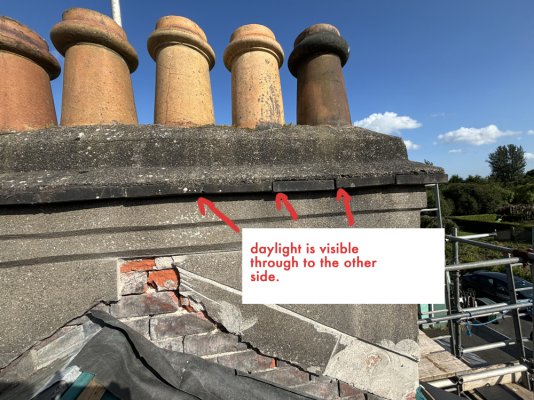
We are removing the render on the rest of the back of the house to resolve the damp as it's badly blown in several places due to neglected gutters etc. The interior was also rendered in sand and cement which removed during the winter months.
I plan to leave the render on the back side of the chimney breast and just remove the render to the wall beside it. The chimney is not in use nor will it be. So I just plan to leave it ventilated.
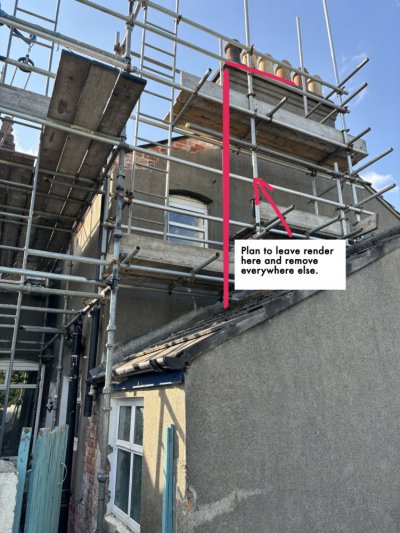
Does anyone have any advice or have dealt with similar?
Given it's a shared chimney I think a rebuild is out of the question.
Thanks for your help!
I'm currently coming towards the end of reroofing our victorian mid terrace house.
It's been a long process. (The previous owners had removed several huge purlins during a very bad loft conversion, installed very inadequate ones and then installed installed heavy concrete roof tiles. (A terrible combination leading to a very bowed roof!)
All of that's been resolved and now I've come to dealing with the last of the three chimneys.
This one is to the very rear of the house and rendered in sand and cement. I have already repointed the other chimneys in lime and given them a new lime flaunching.
These were not rendered so they were much more straight forward to deal with.
Here's the chimney in question. Half our's, half our neighbours.
Below the chimney I rebuilt the top few courses of brick on the gable as what was there had totally disintegrated.

It seems generally in ok condition. However the sand and cement the reverse side on had cracked quite badly around the lead flashing so I started to remove the loose render.
As I was chipping it away I discovered the bricks behind are very loose, the mortar is pretty much dust. (The bricks and mortar below the roofline are fine).
When it was previously rendered there was not enough room left to allow for an adequate lead upstand (much less than 100mm).
Given the condition of the bricks I put down the chisel and have begun to grind the mortar away with a surface grinding disc instead. Not ideal I know, but I don't want to chisel it as the bricks are very loose.
There's also a little bit of a lean on the stack, so again I'm trying to be cautious.



I'm in two minds with how to proceed.
Should I just take the render back enough to allow for good amount of lead coverage and then repair/rebed the loose bricks one by one and then add new lead flashing and re-render with a bellcast/bead?
Or should I remove that section of render completely, repair the bricks and then install more traditional stepped flashing without re-rendering? (I've installed stepped flashing elsewhere)
There's a huge amount to do on this house so I also don't want to just make more work for myself!
The top of the chimney is not in terrible condition but it does have a few cracks. I'm hesitant to take this this off when it seems to be in ok condition. I think here I will just seal up the cracks with lime.

To further complicate things, if I sit on the roof and look side on at the tiles under the flaunching
I can see daylight right out the other side of the chimney! I plan to point all of this up.

We are removing the render on the rest of the back of the house to resolve the damp as it's badly blown in several places due to neglected gutters etc. The interior was also rendered in sand and cement which removed during the winter months.
I plan to leave the render on the back side of the chimney breast and just remove the render to the wall beside it. The chimney is not in use nor will it be. So I just plan to leave it ventilated.

Does anyone have any advice or have dealt with similar?
Given it's a shared chimney I think a rebuild is out of the question.
Thanks for your help!
